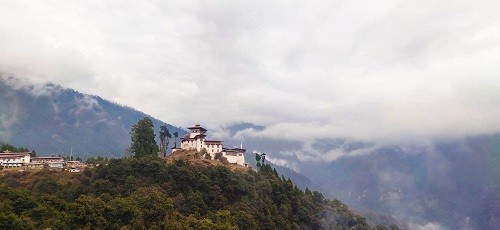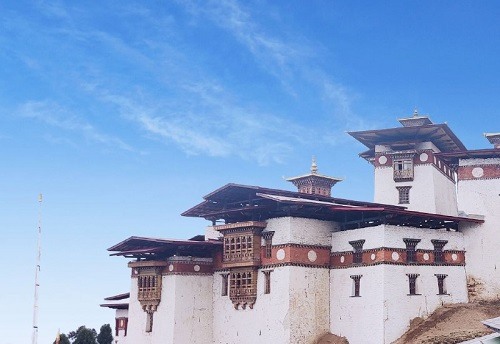Gasa Dzong is the administrative headquarters of Gasa district. The dzong was named after its protector Trashi Thongmon. Legend believes that Zhabdrung, who was greeted by a deity of Gasa when he made his way to Bhutan gave the name of the deity.

Gasa Dzong is located at an elevation of about 2800m. Gasa Dzong was said to have been built by Zhabdrung Nawang Namgyal in 1640s above the cave meditated by a Tibetan saint Terkhungpa. The dzong was often called Gasa Dzong, Ga means ‘blacksmith’ and sa means ‘land’. It refers to Terkungpa who was skilled in blacksmithing.
Gasa Dzong has a unique circular shape with three watchtowers at strategic points. The utse is built directly above the cave where Terkhungpa supposedly meditated. The temple of Kap-Goenm, or Kazhimai Lhakhang, lies to the left of the cave, which houses the images of Buddhas of the tree eras, the past, the present, and the future; the Zhabdrung Ngawang Namgyal; and Guru Rinpoche.
On a clear day, you can get stunning views of Mount Gangboom in the backdrop that enhances the beauty of Gasa Dzong.
It has a great historical, cultural and spiritual significance. Just below is the “La Tsho” which literally means ‘soul lake’. The lake is an important part of the history of Gasa Dzong. Locals believe that Gomo, the guardian of the dzong emerged from this lake in the form of a snake and bound the dzong when Tibetans attacked the dzong with firearms in the 16th century. The surrounding of the lake was developed and named Eto Meto Garden, and was inaugurated by Honourable Agriculture Minister, Dr. Pema Jamtsho on June 2, 2012 to commemorate the Coronation Day of Fourth Druk Gyalpo, Jigme Singye Wangchuck.

A contingent of the monastic body led by the Drapai Lopon (head of the lexicography division of the monastic body) visits Gasa to make the annual offerings to the deities in the last week of the 10th month of the Bhutanese calendar every year. In honor of Mahakala, gun salutations are performed on the 29th day. It is a common belief that during the time of Terkhungpa, there lived a famous Bon master in Gasa. During a competition of spiritual attainment, the Bon master proved that he could walk up the cliff with ease. Terkhungpa perhaps expressed his appreciation of this great achievement. Today, as a token of appreciation to the Bon master, a Bon priest must also participate in the ceremonial procession of the offerings to the Mahakala, wearing his full ritual attire.
Gasa Tshechu is held annually at the same time as Thimphu Tshechu. However, the first day of the tshechu is held in Phu Lhakhang, the original place of the festival.

You can visit Gasa by attempting the world’s toughest trek, Snowman Trek or Gasa-Laya Trek. This remote village in the northwest part of Bhutan is known for its indigenous inhabitants, the Layaps. The Layaps have a very distinct culture, attire and language that is different from the mainstream Bhutanese. They are easily recognised from the iconic conical hats that they wear on their heads.
There is also an annual Royal Highlander Festival celebrated in Gasa every year.